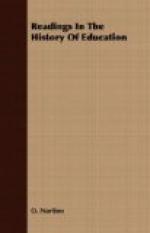Knowledge of the subject should, however, yield much more than understanding: it should also influence the practical attitudes of those who are concerned with university affairs. Here I take issue with those historians who hold that history supplies no “information of practical utility in the conduct of life”; no “lessons directly profitable to individuals and peoples.” The evidence cannot be exhibited here, but such information notoriously has been of the utmost practical value in education, both in shaping influential theories and in determining even minute details of educational practice. There is no reason to suppose that it may not continue to be thus serviceable. Other utilities of university history are less direct, but not less important. The study of individual institutions and their varying circumstances and problems “prepares us to understand and tolerate a variety of usages”; the study of their growth not only “cures us of a morbid dread of change,” but also leads us to view their progressive adaptation to new conditions as necessary and desirable. If such study teaches only these two lessons to those who may hereafter shape the course of educational affairs it more than justifies itself. For to eradicate that intolerance of variety in educational practice so characteristic of the academic man of the past, and to diminish in future generations his equally characteristic opposition to changes involving adaptation to new conditions, is to render one of the greatest possible services to educational progress.
II
THE RENAISSANCE OF THE TWELFTH CENTURY
During the twelfth century a great educational revival manifested itself in western Europe, following upon several centuries of intellectual decline or relative inactivity. Though its beginnings may be traced into the eleventh century, and though its culmination belongs to a much later period, the movement is often called the Renaissance of the Twelfth Century. In that century it first appears as a widely diffused and rapidly growing movement, and it then takes on distinctly the characteristics which mark its later development. The revival appears first in Italy and France; from these regions it spreads during the next three centuries into England, Spain, Germany, Denmark, Sweden, and Scotland.
Certain facts concerning this educational Renaissance should be clearly understood in connection with the following selections:
1. To men of the times it first showed itself as a renewal of activity in existing schools. Here and there appeared eminent teachers; to them resorted increasing numbers of students from greater and greater distances. In a few years some of these institutions became schools of international fame. The newly roused enthusiasm for study in France at the opening of the twelfth century is thus described by a modern writer:




